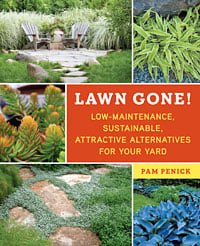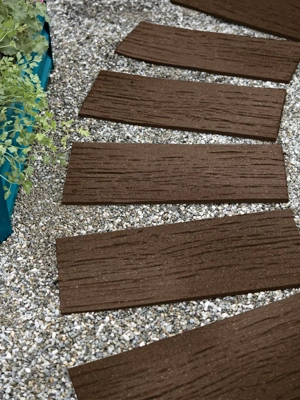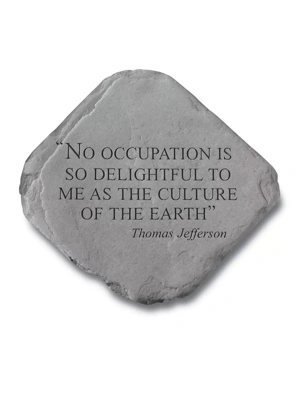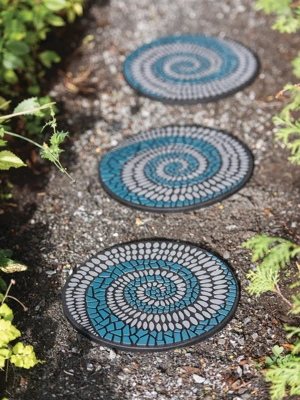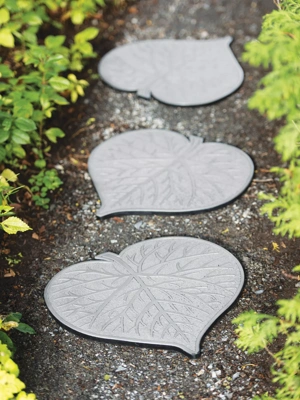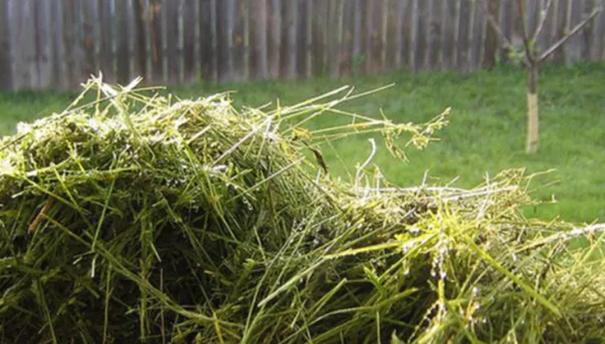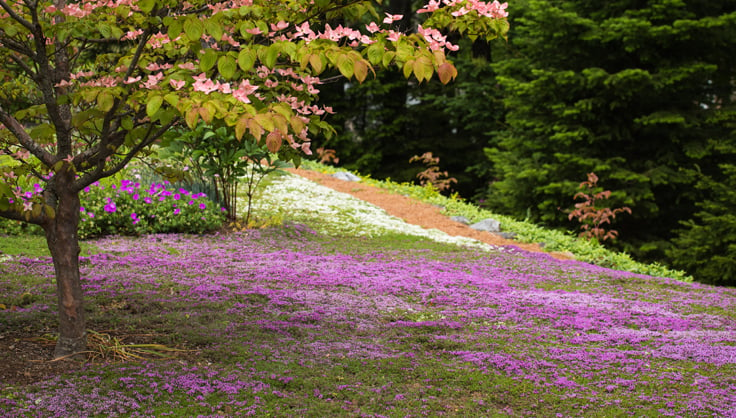Do More with Less Lawn
5 design ideas to break the dominance of turf
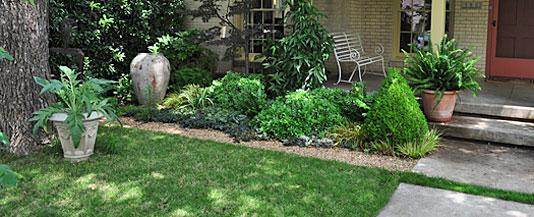
By Pam Penick
Lawn has long enjoyed its unique status as our country's default ground cover — rolled out like wall-to-wall carpeting around every house. The reign of grass is being challenged today, however, as widespread drought, increasing water costs, and awareness of the environmental costs of traditional lawn maintenance (chemical fertilizers, herbicides, and pesticides) have led many people to look for alternatives.
One easy alternative, which can save thousands of gallons of water a year and significantly reduce your maintenance costs, is simply to shrink the lawn to a size that serves a specific purpose. Reduced to a useful size for play or lounging, or as a calm spot to rest the eye, lawn can be part of a greener landscape — and I'm not talking about its emerald hue.
Good design plays a strong part in the success of a smaller, defined lawn. Like other living ground covers, lawn should be used as an intentional design element: Imagine an elegant, green throw rug rather than wall-to-wall carpeting. The resulting negative space is especially welcome in a busily planted garden.
The simplest way to downsize one's lawn is to carve out space for a generous patio near the back or front door, preserving half the lawn (or less) further from the house. If it turns out you want even less grass later on, simply expand your garden borders. Another way to design around a smaller lawn is to treat it as a calm spot amid a highly textured and lushly planted garden. This is an especially appealing approach for plant lovers; a quiet patch of lawn can ground a busy garden.
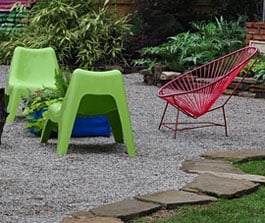
Do you prefer open spaces for entertaining? Then simply replace a large portion of lawn with an economical gravel patio that flows into the remaining lawn. Undulating edges, rather than straight lines, keep the design dynamic and fresh. If, on the other hand, you crave a sense of privacy and serenity, shrink your lawn to a green circle and plant a leafy screen of shrubs and perennials around it. This approach is particularly effective at softening the stark lines of a fenced, empty backyard, so common to new homes. For a more formal look, frame a straight-edged, tidy rectangle of lawn with neat edging, surrounded by lush garden beds. It's a classic look that works as well for a grand, formal house as for a post-war cottage.
Designs with Less Lawn
What all of these downsized lawns share is a sense that they exist for a reason, be it for children to play on, as a soothing counterpoint to a dynamic garden, as a place for relaxation, or as a virtual welcome mat for visitors. They are scaled to their use, with no excess lawn bleeding off into unusable areas that are difficult to mow. Set off by edging, they are contained within the frame of the larger garden, which gives even a smaller lawn more power and presence. If you're ready to lose some but not all of your lawn, try one of these designs.
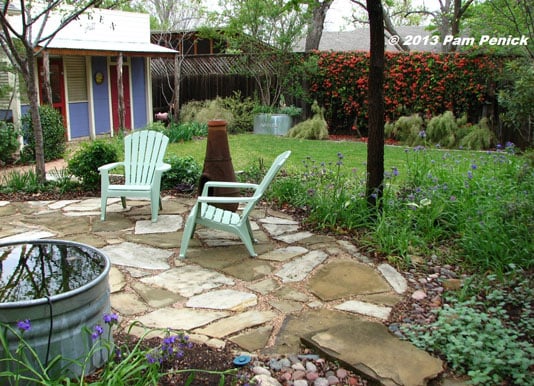
1. Replace half the lawn with a patio and garden bed. In my own former garden, I divided the open, grassy backyard into two sections: a flagstone patio with a container pond and a chiminea for the adult zone, and a rounded-off rectangle of lawn as a play space for our young children. I bordered the lawn with a mix of low-care perennials and ornamental grasses and set it off with edging to define it as an intentional design feature. Mowing time was significantly reduced by shrinking the lawn to a manageable and useful area.
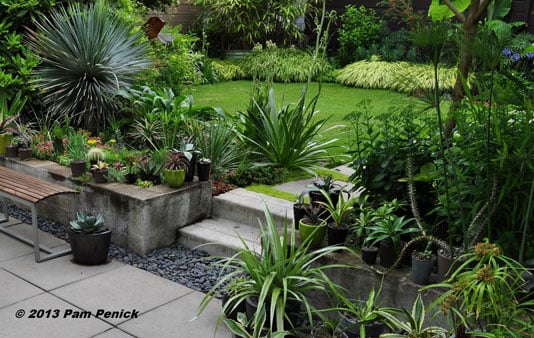
2. Create a calm oasis of lawn amid a lushly planted garden. In her Portland, OR, bungalow's backyard, Loree Bohl shrank her lawn to a petite swath near the house and installed a sunken patio at the rear of the property. A golden necklace of Japanese forest grass (Hakonechloa macra 'Aureola') edges part of the lawn; hostas and other low-growing plants encircle the rest, with taller shrubs tucked further back in the beds. Precisely aligned concrete pavers set in the lawn lead from the house to a sunken patio. In this jam-packed, plant-lover's garden, a simple patch of lawn can be an asset that sets off the textures and colors of surrounding beds.
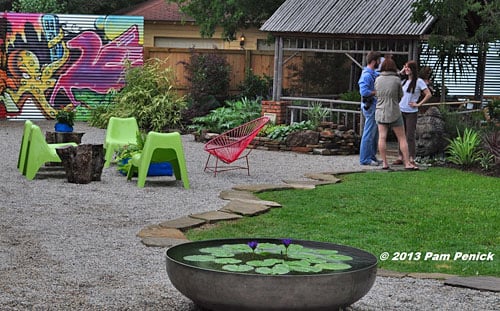
3. Extend a patio with a bit of lawn. In Brianne and Trey Denton's Blue Lotus Garden in Dallas, a gray gravel patio and a remnant of green lawn ebb and flow in the middle of the backyard, with flat-stone edging marking the broad curves where they meet. It's a dynamic design that's perfect for entertaining: Guests can move freely from the patio to the lawn, but the flowing lines keep the space from reading as an empty expanse, the way a large lawn does. The green wedge of grass provides contrasting color and texture and it's sized perfectly for a backyard picnic, toddler play or putting practice.
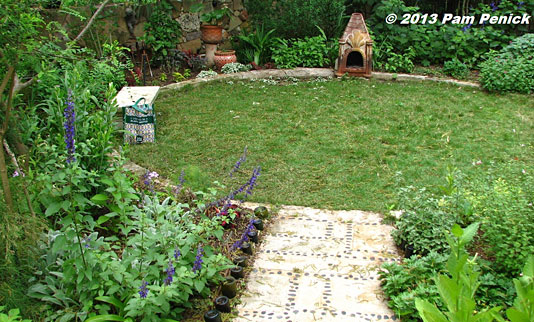
4. Round out the garden with a circular lawn. Austin designer Jill Nokes created this restful glen in her garden by edging a small circle of turf with stone and positioning a simple bench on both sides of the entry path. Directly opposite the entry, a small chiminea serves as a focal point, drawing you into the space. The geometric formality is softened by the surrounding exuberant garden beds and playful hardscape materials, such as the blue-bottle edging and the pattern of river stones pressed into the concrete path.
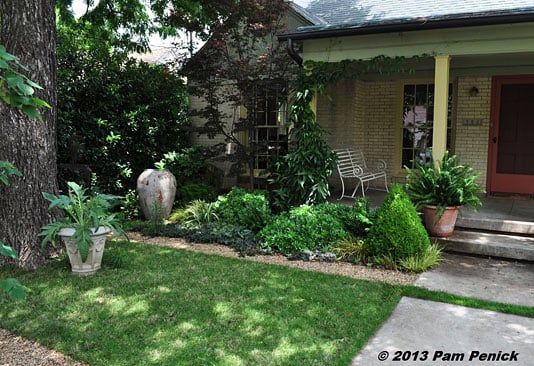
5. Frame a picturesque rectangular lawn. Designer Mike Munsterman whittled a purely decorative lawn down to its essence in the shady front yard of his Dallas home. His pretty-as-a-picture lawn is matted and framed by a border of pea gravel backed by low ground covers and evergreen shrubs. The large concrete pad that crosses the lawn leads to the home's front door on one side and out to a sunny street-side garden on the other. The effect of this narrow, rectangular lawn near the front door is of a green welcome mat.
About the Writer

Pam Penick is a garden designer and gardening coach who hosts the blog, Digging Cool Gardens in a Hot Climate in Austin, TX. Her award-winning blog dishes about xeriscaping, native plants, agave lust, lawn alternatives, and garden design with can-do encouragement and practical advice, spiced up with colorful garden photos.
This article is adapted, with permission, from Lawn Gone! Low-Maintenance, Sustainable, Attractive Alternatives for Your Yard by Pam Penick, copyright 2013.
Her book is a guide to low-water, easy-care lawn alternatives for beginning gardeners and anyone concerned about the environmental costs of maintaining a lawn. Filled with how-to information, design ideas, and inspirational photographs, it covers all the available options: ecological lawns, ornamental grasses, ground-covering plants, small shrubs and perennials, artificial turf, "people places" such as patios and paths, and more. In addition, it includes step-by-step lawn-removal methods, strategies for dealing with HOAs and lawn-loving neighbors, and practical ways to reduce your lawn if you're not ready to go all the way. Regional plant recommendations from 11 garden experts across the U.S. make up a valuable resource for gardeners everywhere.
Pam's articles and photographs have also appeared in Garden Design, Fine Gardening, Austin Home, Fresh Home, and other publications.
Last updated: 03/08/2024
Print this Article:
Related items
Related Articles
Get the Dirt
Stay up to date on new articles and advice. Please fill out the information below.

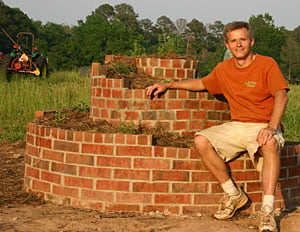 Dave Whitinger
Dave Whitinger